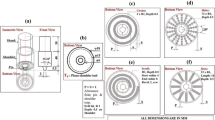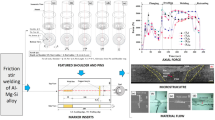Abstract
In marine application, marine grade steel is generally used for haul and superstructures. However, aluminum has also become a good choice due to its lightweight qualities, while rusting of aluminum is minimal compared to steel. In this paper a study on friction stir welding of aluminum alloys was presented. The present investigation deals with the effects of different friction stir welding tool geometries on mechanical strength and the microstructure properties of aluminum alloy welds. Three distinct tool geometries with different types of shoulder and tool probe profiles were used in the investigation according to the design matrix. The effects of each tool shoulder and probe geometry on the weld was evaluated. It was also observed that the friction stir weld tool geometry has a significant effect on the weldment reinforcement, microhardness, and weld strength.
Similar content being viewed by others
References
Barcellona A, Buffa G, Fratini L (2004). Pin shape effect on friction stir welding of AA 6082-T6 sheets. Proceedings of the 4th CIRP International Seminar on Intelligent Computation in Manufacturing Engineering (ICME 04), Sorrento, Italy, 499–502.
Biswas P, Mandal NR (2009). Experimental study on friction stir welding of marine grade aluminum alloy. Journal of Ship Production, 25, 1–6.
Boz M, Kurt A (2004). The influence of stirrer geometry on bonding and mechanical properties in friction stir welding process. Materials & Design, 25, 343–347.
Dawes CJ, Thomas W M (1999). Development of improved tool designs for friction stir welding of aluminium. Proceedings of the 1st International Friction Stir Welding Symposium, Oaks, CA, USA.
Fujii H, Cui L, Maeda M, Nogi K (2006). Effect of tool shape on mechanical and microstructure of friction stir welded aluminum alloy, Materials Science and Engineering A, 419, 25–31.
Leal RM, Leitao C, Loureiro A, Rodrigues DM, Vilac P (2008). Material flow in heterogeneous friction stir welding of thin aluminium sheets: Effect of shoulder geometry. Materials Science and Engineering, 498, 384–391.
Lee WB, Yeon YM, Jung SB (2003). Evaluation of the microstructure and mechanical properties of friction stir welded 6005 aluminum alloy. Mater Sci Technol, 19, 1513–1518.
Nunes AC, Guerra M, Schmidt C, Mcclure JC, Murr LE (2002) Flow patterns during friction stir welding. Materials Characterization, 49, 95–101.
Rajakumar S, Muralidharan C, Balasubramanian V (2010). Optimization of the friction stir welding process and tool parameters to attain a maximum tensile strength of AA7075-T6 aluminum alloy. Proc. IMechE Part B: J. Engineering Manufacture, 224, 1175–1190.
Sato YS, Urata M, Kokawa H (2002). Parameters controlling microstructure and hardness during friction-stir welding of precipitation-hardenable aluminum alloy 6063. Metal Mater Trans A, 33, 625–635.
Scialpi A, Filippis LAC De, Cavaliere P (2007). Influence of shoulder geometry on microstructure and mechanical properties of friction stir welded 6082 aluminium alloy. Materials and Design, 28, 1124–1129.
Su JQ, Nelson TW, Mishra R, Mahoney MW (2003). Microstructural investigation of friction stir welded 7050-T651 alloy. Acta Mat., 51, 713–729.
Thomas WM, Threadgill PL, Nicholas ED (1999). The feasibility of friction stir welding steel. Science and Technology of Welding and Joining, 4, 365–372.
Thomas WM, Nicholas ED, Needham, JC, Murch MG, Temple-Smith P, Dawes CJ (1993). Friction stir butt welding (The Welding Institute (TWI)). PCT World Patent Application WO93/10935; field: 27 November 1992(UK 9125978.8, 6 December 1991); publication: 10 June 1993.
Author information
Authors and Affiliations
Corresponding author
Additional information
H. K. Mohanty was born in 1965. He has more than twenty years of experience in imparting technical education and training in government-run institutions. He is currently working as a research scholar in the Mechanical and Industrial Engineering Department of IIT Roorkee sponsored by the government of Orissa, India. His research topic is related to the modeling of the frition stir welding process while considering the effects of tool geometries.
M. M. Mahapatra was born in 1970. He is working as an assistant professor at the Mechanical and Industrial Engineering Department at IIT, Roorkee. His current research interests include welding deformation and residual stress analysis, design of welded structures, and development of the friction stir welding process.
Pradeep Kumar is a professor in the Mechanical and Industrial Engineering Department, IIT, Roorkee. His research interests include supply chain management, advanced manufacturing processes, metal casting, microwave joining of metals, and solid state joining of metals.
Pankaj Biswas was born in 1979. He is an assistant professor in the IIT Guwahati, Dept. of Mechanical Engineering. His current research interests include manufacturing and design: computational weld mechanics, ship production, and friction stir welding modeling.
Nisith Ranjan Mandal was born in 1954. He is a professor in the IIT Kharagpur, Dept. of OE&NA. His current research interests include ship production, ship design, line heating, welding distortion of large stiffened structures, and friction stir welding techniques.
Rights and permissions
About this article
Cite this article
Mohanty, H.K., Mahapatra, M.M., Kumar, P. et al. Effect of tool shoulder and pin probe profiles on friction stirred aluminum welds — a comparative study. J. Marine. Sci. Appl. 11, 200–207 (2012). https://doi.org/10.1007/s11804-012-1123-4
Received:
Published:
Issue Date:
DOI: https://doi.org/10.1007/s11804-012-1123-4




